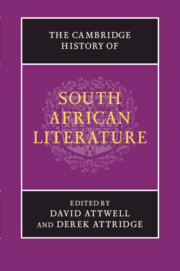Book contents
- Frontmatter
- Introduction
- PART I ORATURES, ORAL HISTORIES, ORIGINS
- PART II EXPLORATION, EARLY MODERNITY AND ENLIGHTENMENT AT THE CAPE, 1488–1820
- PART III EMPIRE, RESISTANCE AND NATIONAL BEGINNINGS, 1820–1910
- 9 Writing settlement and empire: the Cape after 1820
- 10 The mission presses and the rise of black journalism
- 11 The imperial romance
- 12 Perspectives on the South AfricanWar
- 13 The beginnings of Afrikaans literature
- PART IV MODERNISM AND TRANSNATIONAL CULTURE, 1910–1948
- PART V APARTHEID AND ITS AFTERMATH, 1948 TO THE PRESENT
- PART VI SOUTH AFRICAN LITERATURE: CONTINUITIES AND CONTRASTS
- Index
- References
11 - The imperial romance
from PART III - EMPIRE, RESISTANCE AND NATIONAL BEGINNINGS, 1820–1910
Published online by Cambridge University Press: 28 January 2012
- Frontmatter
- Introduction
- PART I ORATURES, ORAL HISTORIES, ORIGINS
- PART II EXPLORATION, EARLY MODERNITY AND ENLIGHTENMENT AT THE CAPE, 1488–1820
- PART III EMPIRE, RESISTANCE AND NATIONAL BEGINNINGS, 1820–1910
- 9 Writing settlement and empire: the Cape after 1820
- 10 The mission presses and the rise of black journalism
- 11 The imperial romance
- 12 Perspectives on the South AfricanWar
- 13 The beginnings of Afrikaans literature
- PART IV MODERNISM AND TRANSNATIONAL CULTURE, 1910–1948
- PART V APARTHEID AND ITS AFTERMATH, 1948 TO THE PRESENT
- PART VI SOUTH AFRICAN LITERATURE: CONTINUITIES AND CONTRASTS
- Index
- References
Summary
The South African imperial romance was a major cultural phenomenon. It peaked between 1885 and 1925, when writers published, and frequently reprinted, over one hundred romances. Rider Haggard's King Solomon's Mines (1885) established the prototype, with its British chivalric heroes, magnificent African warriors, faithful African servants, demonicAfrican ‘witchdoctors’, big game hunting, hidden treasure and ancient civilisations. Haggard uses standard narrative features of the romance mode: a regenerative quest, marvellous episodes, coincidences, hazardous landscape, limited characterisation, and heroic triumph over a series of increasingly difficult challenges. To romance's socially conservative ethos he, and subsequent writers, added the particular racial and national inflections of British imperialism, which glorify the British as the epitome of bravery and humane paternalism. English and, at times, Scottish and Irish heroes embody these imperial-national characteristics, and operate as agents of morality, justice and order.
Some prolific romancers, such as Bertram Mitford and Ernest Glanville, specialised in the South African region. Other equally prolific authors devoted only a few volumes to the country, out of their multinational range; these include British juvenile writers such as Lieutenant-Colonel F. S. Brereton, Janet Gordon, G. A. Henty, W. H. G. Kingston, Bessie Marchant, Frederick Wishaw and May Wynne.
- Type
- Chapter
- Information
- The Cambridge History of South African Literature , pp. 226 - 245Publisher: Cambridge University PressPrint publication year: 2012
References
- 2
- Cited by

